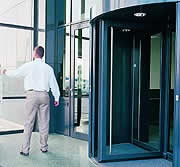The systemsoftware is installed on a Server together with all other software tools required in each installation.
The Access Control readers are installed on and connected to the electric door locks they are intended to control. The readers may also be connected directly to turnstiles, vehicle access barriers, security doors etc. They are then connected through cabling to the respective controllers.
The controllers are connected to the system software through a network (Ethernet TCP/IP) or through a serial RS-485 interface.
The next step, after all hardware and software has been installed, is to enter in the system software the details of each member of staff and the access rights and limitations applicable to each member of staff and each door controlled by the system, and to parameterise the software based on the needs of each installation. Once these tasks are completed, the system is ready for use.
Once the system is put to operation, access to all controlled spaces is only possible through authorised use of the Soyal access system.
To enter the controlled premises, staff and visitors need to use their special proximity IDs or those and a keyboard. Where this required by the nature of the installation, access may be also controlled by means of special biometric terminals, which offer top security standards in terms of human identification.
Every attempt to enter the premises controlled by the system is automatically checked by the respective IDT controller. If the person trying to enter has authorised access, the system unblocks the door or turnstile allowing the person to enter, and at the same time records this action in the Controller's memory. In case of unauthorised access, the Access Control reader transmits an audiovisual signal indicating restricted entry and records the attempted entry in the controller's memory, and may even transmit an alarm signal, if programmed accordingly.
 Soyal's access control system is a modern, reliable and very cost-effective access control system.
Soyal's access control system is a modern, reliable and very cost-effective access control system.

